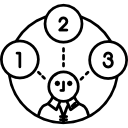Programming language
This is one of the most important ideas you can remember:
Decompose a problem into smaller parts, model a problem with flowcharts. Learn to think sequentially

Computational thinking and problem-solving[1]
Introduction to programming[edit]
- What is a programming language?
- High level languages
- Low level languages
- Compiler
- Translating high-level code to low-level code
- Control flow
Other important ideas in programming[edit]
Standards[edit]
| Computational thinking, problem-solving and programming | |
| Identify the procedure appropriate to solving a problem. | Computational Thinking |
| Evaluate whether the order in which activities are undertaken will result in the required outcome. | Computational Thinking |
| Explain the role of sub-procedures in solving a problem. | Computational Thinking |
| Identify when decision-making is required in a specified situation. | Computational Thinking |
| Identify the decisions required for the solution to a specified problem. | Computational Thinking |
| Identify the condition associated with a given decision in a specified problem. | Computational Thinking |
| Explain the relationship between the decisions and conditions of a system. | Computational Thinking |
| Deduce logical rules for real-world situations. | Computational Thinking |
| Identify the inputs and outputs required in a solution. | Computational Thinking |
| Identify pre-planning in a suggested problem and solution. | Computational Thinking |
| Explain the need for pre-conditions when executing an algorithm. | Computational Thinking |
| Outline the pre- and post-conditions to a specified problem. | Computational Thinking |
| Identify exceptions that need to be considered in a specified problem solution. | Computational Thinking |
| Identify the parts of a solution that could be implemented concurrently. | Computational Thinking |
| Describe how concurrent processing can be used to solve a problem. | Computational Thinking |
| Evaluate the decision to use concurrent processing in solving a problem. | Computational Thinking |
| Identify examples of abstraction. | Computational Thinking |
| Explain why abstraction is required in the derivation of computational solutions for a specified situation. | Computational Thinking |
| Construct an abstraction from a specified situation. | Computational Thinking |
| Distinguish between a real-world entity and its abstraction. | Computational Thinking |
| Describe the characteristics of standard algorithms on linear arrays. | Computational Thinking |
| Outline the standard operations of collections. | Computational Thinking |
| Discuss an algorithm to solve a specific problem. | Computational Thinking |
| Analyse an algorithm presented as a flow chart. | Computational Thinking |
| Analyse an algorithm presented as pseudocode. | Computational Thinking |
| Construct pseudocode to represent an algorithm. | Computational Thinking |
| Suggest suitable algorithms to solve a specific problem. | Computational Thinking |
| Deduce the efficiency of an algorithm in the context of its use. | Computational Thinking |
| Determine the number of times a step in an algorithm will be performed for given input data. | Computational Thinking |
| State the fundamental operations of a computer. | Computational Thinking |
| Distinguish between fundamental and compound operations of a computer. | Computational Thinking |
| Explain the essential features of a computer language. | Computational Thinking |
| Explain the need for higher level languages. | Computational Thinking |
| Outline the need for a translation process from a higher level language to machine executable code. | Computational Thinking |
| Define the terms: variable, constant, operator, object. | Computational Thinking |
| Define common operators. | Computational Thinking |
| Analyse the use of variables, constants and operators in algorithms. | Computational Thinking |
| Construct algorithms using loops, branching. | Computational Thinking |
| Describe the characteristics and applications of a collection. | Computational Thinking |
| Construct algorithms using the access methods of a collection. | Computational Thinking |
| Discuss the need for sub-programmes and collections within programmed solutions. | Computational Thinking |
| Construct algorithms using pre- defined sub-programmes, one- dimensional arrays and/or collections. | Computational Thinking |